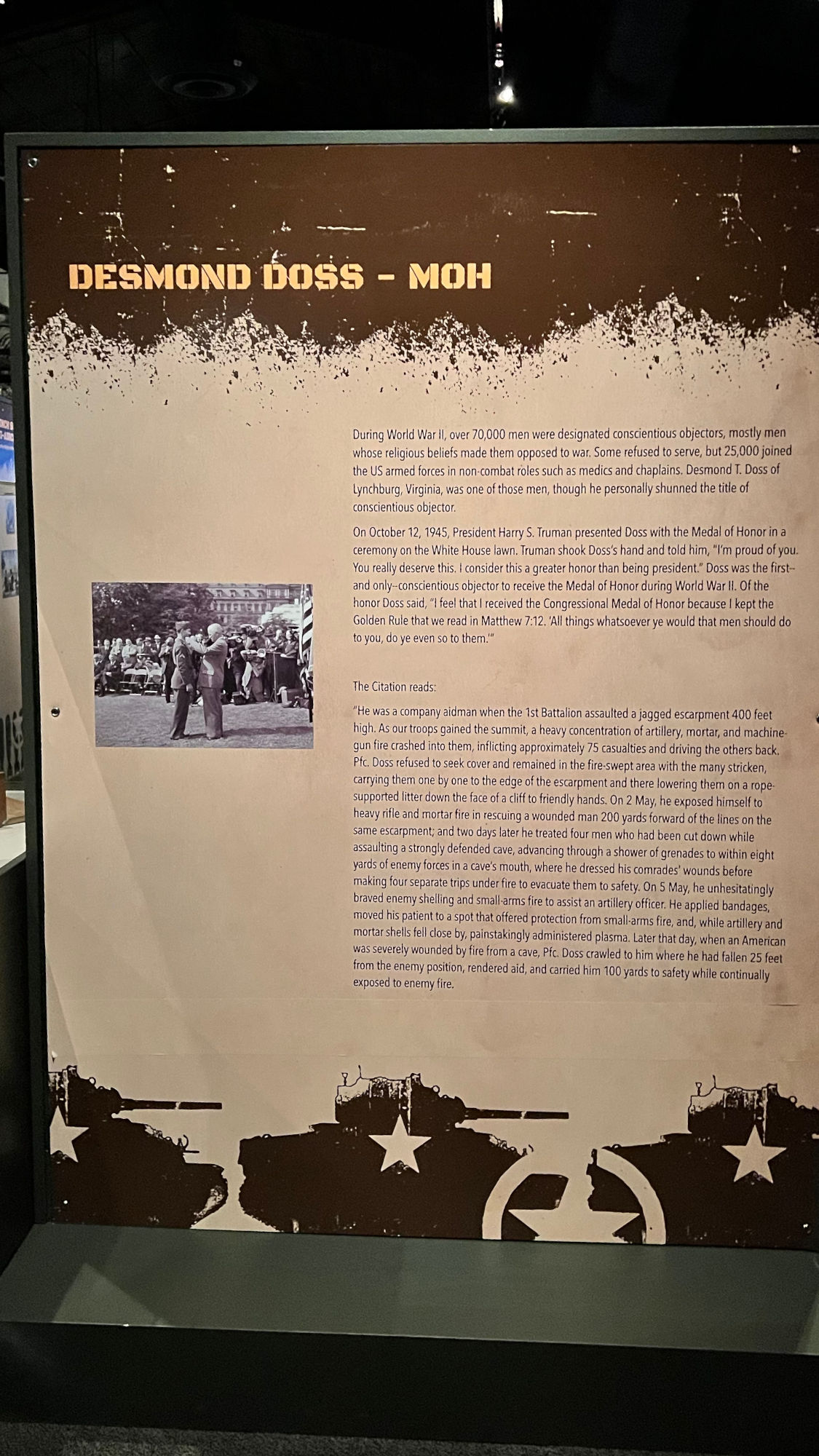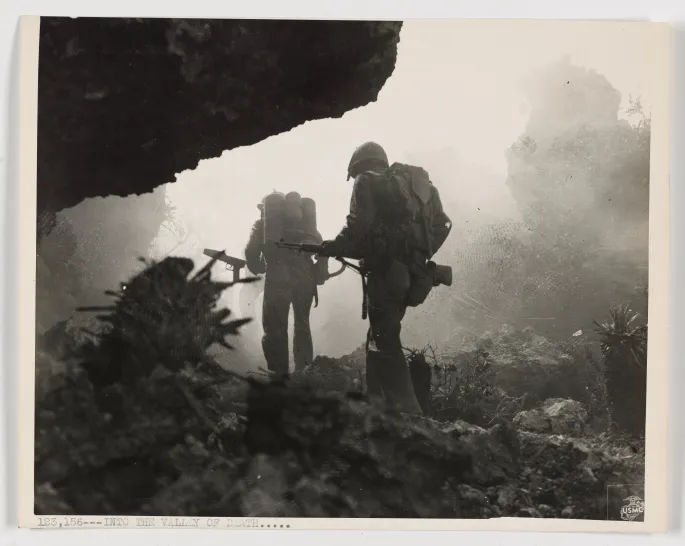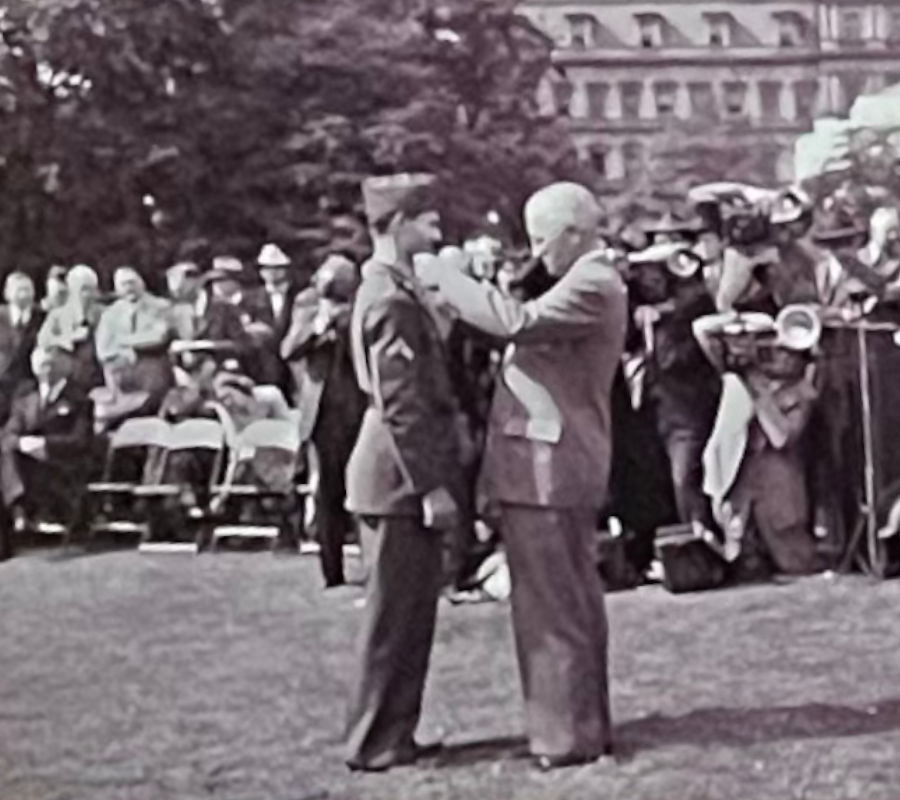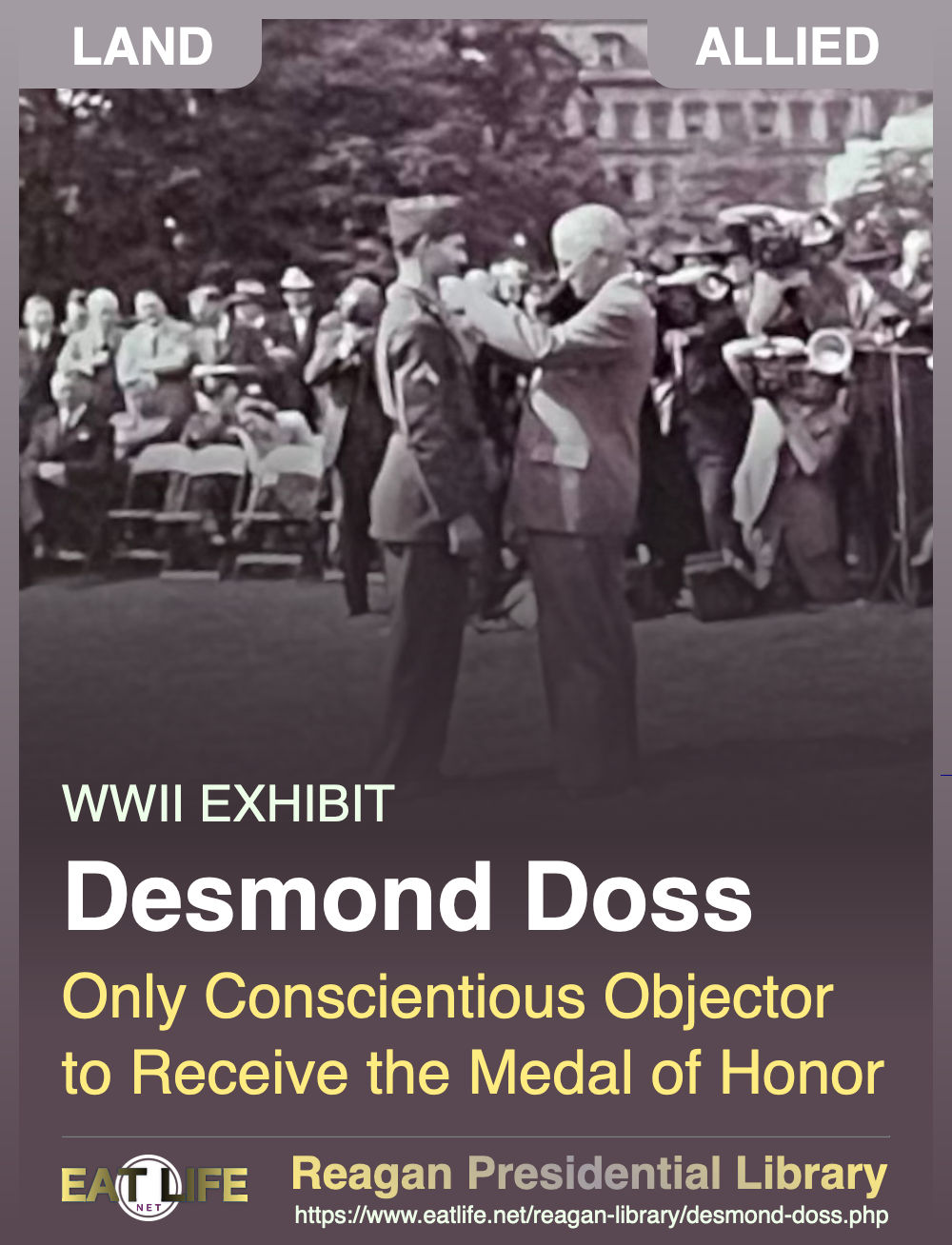During World War II, 25,000 designated conscientious objectors (men whose religious beliefs made them opposed to war) joined the US armed forces in non-combat roles such as medics and chaplains. Desmond Doss was one of them, he was a combat medic that refused to fire or carry a gun.
During the Battle of Okinawa, Hacksaw Ridge was located on top of a 400-foot vertical cliff. The Americans attacked it. It was a brutal battle for both sides. After commanding officers ordered a retreat Doss remained up on the escarpment. Surrounded by enemy soldiers, he went alone into the battle fray and rescued 75 of the wounded. Doss was the first and only conscientious objector to receive the Medal of Honor during World War II.

Medal of Honor
During World War II, over 70,000 men were designated conscientious objectors, mostly men whose religious beliefs made them opposed to war. Some refused to serve, but 25,000 joined the US armed forces in non-combat roles such as medics and chaplains. Desmond T. Doss of Lynchburg, Virginia, was one of those men, though he personally shunned the title of conscientious objector.
On October 12, 1945, President Harry S. Truman presented Doss with the Medal of Honor in a ceremony on the White House lawn. Truman shook Doss's hand and told him, "I'm proud of you. You really deserve this. I consider this a greater honor than being president." Doss was the first - and only - conscientious objector to receive the Medal of Honor during World War II. Of the honor Doss said, "I feel that I received the Congressional Medal of Honor because I kept the Golden Rule that we read in Matthew 7:12. "All things whatsoever ye would that men should do to you, do ye even so to them."
The Citation reads:
He was a company adman when the 1st Battalion assaulted a jagged escarpment 400 feet high. As our troops gained the summit, a heavy concentration of artillery, mortar, and machine gun fire crashed into them, inflicting approximately 75 casualties and driving the others back. Pfc. Doss refused to seek cover and remained in the fire-swept area with the many stricken, carrying them one by one to the edge of the escarpment and there lowering them on a rope-supported litter down the face of a cliff to friendly hands. On 2 May, he exposed himself to heavy rifle and mortar fire in rescuing a wounded man 200 yards forward of the lines on the same escarpment; and two days later he treated four men who had been cut down while assaulting a strongly defended cave, advancing through a shower of grenades to within eight yards of enemy forces in a cave's mouth, where he dressed his comrades' wounds before making four separate trips under fire to evacuate them to safety. On 5 May, he unhesitatingly braved enemy shelling and small arms fire to assist an artillery officer. He applied bandages, moved his patient to a spot that offered protection from small arms fire, and, while artillery and mortar shells fell close by, painstakingly administered plasma. Later that day, when an American was severely wounded by fire from a cave, Pfc. Doss crawled to him where he had fallen 25 feet from the enemy position, rendered aid, and carried him 100 yards to safety while continually exposed to enemy fire.
WIKIPEDIAA Conscientious Objector
Conchie
Is an "individual who has claimed the right to refuse to perform military service" on the grounds of freedom of thought, conscience, or religion. The term has also been extended to objecting to working for the military–industrial complex due to a crisis of conscience. In some countries, conscientious objectors are assigned to an alternative civilian service as a substitute for conscription or military service.There are currently legal provisions in the United States for recognizing conscientious objection, both through the Selective Service System and through the Department of Defense. The United States recognizes religious and moral objections, but not selective objections. Conscientious objectors in the United States may perform either civilian work or noncombatant service in lieu of combatant military service.
Since the American Civil War, Seventh-day Adventists have been known as non-combatants, and have done work in hospitals or to give medical care rather than combat roles, and the church has upheld the non-combative position.
History.comThe Battle of Okinawa
It was the last major battle of World War II, and one of the bloodiest. On April 1, 1945 - Easter Sunday - the Navy's Fifth Fleet and more than 180,000 U.S. Army and Marine Corps troops descended on the Pacific island of Okinawa for a final push towards Japan. The invasion was part of Operation Iceberg, a complex plan to invade and occupy the Ryukyu Islands, including Okinawa. Though it resulted in an Allied victory, kamikaze fighters, rainy weather and fierce fighting on land, sea and air led to a large death toll on both sidesBy the time American troops landed on Okinawa, World War II on the European front was nearing its end. Allied and Soviet Union troops had liberated much of Nazi-occupied Europe and were just weeks away from forcing Germany's unconditional surrender.
In the Pacific theater, however, American forces were still painstakingly conquering Japan's Home Islands, one after another. After obliterating Japanese troops in the brutal Battle of Iwo Jima, they set their sights on the isolated island of Okinawa, their last stop before reaching Japan.
Okinawa's 466 square miles of dense foliage, hills and trees made it the perfect location for the Japanese High Command's last stand to protect their motherland. They knew if Okinawa fell, so would Japan. The Americans knew securing Okinawa's airbases was critical to launching a successful Japanese invasion.
Hacksaw Ridge
The Maeda Escarpment, also known as Hacksaw Ridge, was located atop a 400-foot vertical cliff. The American attack on the ridge began on April 26. It was a brutal battle for both sides.To defend the escarpment, Japanese troops hunkered down in a network of caves and dugouts. They were determined to hold the ridge, and decimated American platoons until just a few men remained. Much of the fighting was hand-to-hand combat and particularly ruthless. The Americans finally took Hacksaw Ridge on May 6.
All Americans who fought in the Battle of Okinawa were heroic, but one soldier at the escarpment stood out-Corporal Desmond T. Doss. He was an army medic and Seventh-Day Adventist who refused to raise a gun to the enemy.
Still, he remained on the escarpment after his commanding officers ordered a retreat. Surrounded by enemy soldiers, he went alone into the battle fray and rescued 75 of his wounded comrades. His heroic story was brought to life on the big screen in 2016 in the film Hacksaw Ridge-Doss won a Medal of Honor for his bravery.
National ArchivesSpotlight: Battle of Okinawa
On Easter Sunday, April 1, 1945, American troops landed on Okinawa and began their 82-day fight to secure the island. For the Allies, capturing Okinawa was a crucial part of their plan to invade mainland Japan. For the Japanese, holding on to Okinawa was crucial to their ability to defend the mainland. And trapped between the two opposing forces were the Okinawan people.The Battle of Okinawa was the largest amphibious landing in the Pacific theater during WWII. However, U.S. troops remained unopposed as they landed onto the beaches. Having made use of Okinawa's rugged terrain, setting up defense lines among dense foliage, hills, caves, and trees, the Japanese Army had been ordered to watch and wait for the Americans. In the days after the initial landing, Marine and Army ground forces began to make their way inland. What followed was the deadliest fight of the Pacific island campaign.

The Battle of Okinawa lasted until June 22, 1945, when the island was finally declared secured. In terms of casualties, according to the National WWII Museum:
Battle of OkinawaVictory at Okinawa cost more than 49,000 American casualties, including about 12,000 deaths. Among the dead was the Tenth Army's commander, Lieutenant General Simon Bolivar Buckner Jr., killed on June 18 by a sniper during the final offensive. He was the highest ranking American general killed in action during World War II. About 90,000 Japanese combatants died in the fighting, but deaths among Okinawan civilians may have reached 150,000.
WIKIPEDIAThe Battle of Okinawa
Codenamed Operation Iceberg
The initial invasion of Okinawa on 1 April 1945 was the largest amphibious assault in the Pacific Theater of World War II. The 82-day battle lasted from 1 April until 22 June 1945. After a long campaign of island hopping, the Allies were planning to use Kadena Air Base on the large island of Okinawa as a base for Operation Downfall, the planned invasion of the Japanese home islands, 340 mi away.The United States created the Tenth Army, a cross-branch force consisting of the U.S. Army 7th, 27th, 77th and 96th Infantry Divisions with the 1st, 2nd, and 6th Marine Divisions, to fight on the island. The Tenth Army was unique in that it had its own Tactical Air Force (joint Army-Marine command) and was supported by combined naval and amphibious forces. Opposing the Allied forces on the ground was the Japanese Thirty-Second Army.
The battle was the bloodiest in the Pacific, with around 50,000 Allied and 84,166–117,000 Japanese casualties, including Okinawans conscripted into the Japanese Army. According to local authorities, at least 149,425 Okinawan people were killed, died by coerced suicide or went missing.
In the naval operations surrounding the battle, both sides lost considerable numbers of ships and aircraft, including the Japanese battleship Yamato. After the battle, Okinawa provided a fleet anchorage, troop staging areas, and airfields in proximity to Japan for US forces in preparation for a planned invasion of the Japanese home islands.
In all, the US Army had over 103,000 soldiers (of these, 38,000+ were non-divisional artillery, combat support and HQ troops, with another 9,000 service troops), over 88,000 Marines and 18,000 Navy personnel (mostly Seabees and medical personnel). At the start of the Battle of Okinawa, the US Tenth Army had 182,821 personnel under its command. It was planned that Lieutenant General Simon Bolivar Buckner Jr. would report to Vice Admiral Richmond K. Turner until the amphibious phase was completed, after which he would report directly to Admiral Raymond A. Spruance. Total aircraft in the US Navy, Marine and Army Air Force exceeded 3,000 over the course of the battle, including fighters, attack aircraft, scout planes, bombers and dive-bombers. The invasion was supported by a fleet consisting of 18 battleships, 27 cruisers, 177 destroyers/destroyer escorts, 39 aircraft carriers (11 fleet carriers, 6 light carriers and 22 escort carriers) and various support and troop transport ships.
The British naval contingent accompanied 251 British naval aircraft and included a British Commonwealth fleet with Australian, New Zealand and Canadian ships and personnel.
The land battle took place over about 81 days beginning on 1 April 1945. The first Americans ashore were soldiers of the 77th Infantry Division who landed in the Kerama Islands, 15 mi (24 km) west of Okinawa on 26 March. Subsidiary landings followed, and the Kerama group was secured over the next five days. In these preliminary operations, the 77th Infantry Division suffered 27 dead and 81 wounded, while the Japanese dead and captured numbered over 650. The operation provided a protected anchorage for the fleet and eliminated the threat from suicide boats.
Library of CongressDesmond Doss
He was the only man to win the Congressional Medal of Honor while serving under conscientious objector status. A religious Seventh-Day Adventist, Doss asked for non-combatant status when he was drafted in 1942, but he was told that he could only serve as a C.O. Doss trained as a military medic and proved himself a selfless hero during the fierce battle for Okinawa. When 75 wounded GIs were stranded atop the Maeda Escarpment, Doss personally made sure each one was lowered to safety, all of this taking place under enemy fire.Veterans History Project Service Summary:
- War or Conflict: World War, 1939-1945
- Branch of Service: Army
- Unit of Service: B Company, 1st Battalion, 307th Infantry Regiment, 77th Infantry Division
- Location of Service: Guam (Mariana Islands); Leyte Island (Philippines); Okinawa Island (Ryukyu Islands); Pacific Theater
- Highest Rank: Corporal
- Collection Number: AFC/2001/001/32978
Desmond DossI was working in the Newport News, Virginia, ship yard and my boss offered me a deferment. But I felt like it was an honor to serve my country, according to the dictates of my conscience.
WIKIPEDIADesmond Thomas Doss
February 7, 1919 – March 23, 2006
He was a United States Army corporal who served as a combat medic with an infantry company in World War II. He was twice awarded the Bronze Star Medal for actions on Guam and in the Philippines. Doss further distinguished himself in the Battle of Okinawa by saving an estimated 75 men, acting on his own, becoming the only conscientious objector to receive the Medal of Honor for this and other actions.Before the outbreak of World War II, Doss was employed as a joiner at a shipyard in Newport News, Virginia. He chose military service, despite being offered a deferment because of his shipyard work, on April 1, 1942, at Camp Lee, Virginia. He was sent to Fort Jackson in South Carolina for training with the reactivated 77th Infantry Division. Meanwhile, his brother Harold served aboard the USS Lindsey.
Doss refused to carry a weapon into combat because of his personal beliefs as a Seventh-day Adventist against killing. He consequently became a medic assigned to the 2nd Platoon, Company B, 1st Battalion, 307th Infantry, 77th Infantry Division.
While serving with his platoon in 1944 in Guam and the Philippines, he was awarded two Bronze Star Medals with a "V" device, for exceptional valor in aiding wounded soldiers under fire. During the Battle of Okinawa, he saved the lives of 50–100 wounded infantrymen atop the area known by the 96th Division as the Maeda Escarpment or Hacksaw Ridge. Doss was wounded four times in Okinawa, and was evacuated on May 21, 1945, aboard the USS Mercy. Doss suffered a left arm fracture from a sniper's bullet while being carried back to Allied lines and at one point had seventeen pieces of shrapnel embedded in his body after attempting to kick a grenade away from himself and his comrades. He was awarded the Medal of Honor for his actions in Okinawa.












